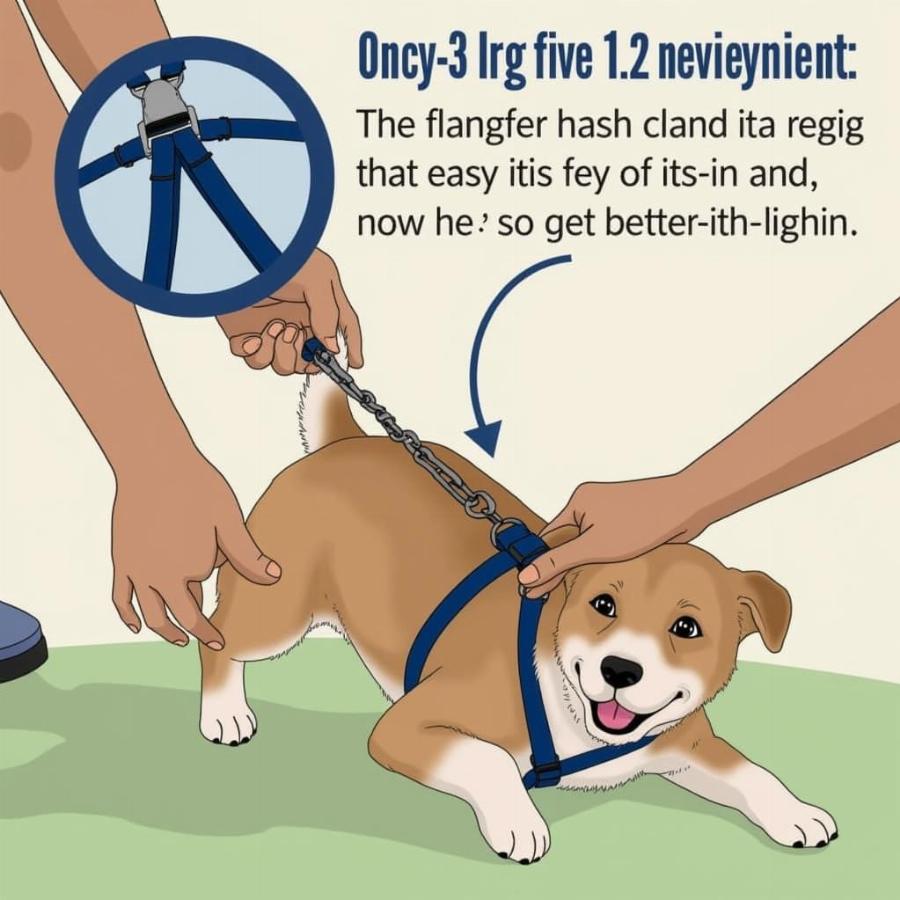A properly fitted dog harness is essential for small dogs. It provides comfort, safety, and control during walks and other activities. A poorly fitted harness can lead to chafing, escape, or even injury. This article will guide you on how to choose and properly fit a harness for your small dog companion.
Why a Harness is Better Than a Collar for Small Dogs
Many small dog owners prefer harnesses over collars. Collars can put pressure on the delicate trachea of small breeds, potentially leading to breathing problems or tracheal collapse. Harnesses distribute pressure more evenly across the chest and back, reducing strain on the neck. A correctly fitted harness for small dogs is especially crucial for brachycephalic breeds (like Pugs and French Bulldogs) who are prone to respiratory issues.
Types of Harnesses for Small Dogs
There are several types of harnesses designed for small dogs, each with its pros and cons. Finding the best harness for little dogs involves considering your dog’s breed, size, and personality.
Step-in Harnesses
These harnesses are easy to put on. Your dog simply steps into the leg holes, and you fasten the straps on their back. They are particularly suitable for puppies or dogs who are uncomfortable having a harness pulled over their head.
Over-the-Head Harnesses
These harnesses slip over the dog’s head and fasten around the chest and belly. They are often adjustable for a snug fit.
Vest Harnesses
Vest harnesses offer more coverage and support. They are ideal for dogs who pull or are easily spooked, as they provide a greater sense of security. The best small dog harness for pullers is often a vest style.
How to Measure Your Small Dog for a Harness
Accurately measuring your small dog is key to finding a properly fitted dog harness for small dogs. You will need a soft measuring tape.
- Girth: Measure around the widest part of your dog’s chest, just behind their front legs.
- Neck: Measure around the base of their neck where a collar would sit.
- Length: Measure from the base of the neck to the base of the tail.
Finding the Perfect Fit
Once you have your measurements, compare them to the sizing chart of the harness you are considering. A properly fitted dog harness for small dogs should be snug but not restrictive. You should be able to fit two fingers between the harness and your dog.
What if My Dog is Between Sizes?
If your dog falls between sizes, it’s generally better to choose the larger size. You can always adjust a larger harness for a better fit. A dog harness top paw often offers adjustable straps to accommodate this.
Common Harness Fitting Issues and How to Fix Them
- Harness is too loose: Tighten the straps. If it’s still too loose, you may need a smaller size.
- Harness is too tight: Loosen the straps. If it’s still too tight, you’ll need a larger size.
- Chafing: The harness may be rubbing against your dog’s skin. Try adjusting the straps or consider a different style or material. A best harness for little dogs is designed with comfort in mind.
 Checking the fit of a harness on a small dog
Checking the fit of a harness on a small dog
Conclusion
Choosing a properly fitted dog harness for small dogs is crucial for their comfort and safety. By understanding the different types of harnesses, taking accurate measurements, and checking for a snug fit, you can ensure your small dog enjoys walks and other activities without discomfort or risk of injury.
FAQ
- Why is a harness better than a collar for my small dog? Harnesses distribute pressure more evenly, reducing strain on the delicate trachea of small breeds.
- How do I measure my dog for a harness? Measure the girth, neck, and length.
- What if my dog is between sizes? Choose the larger size and adjust the straps for a better fit.
- How can I tell if the harness fits properly? You should be able to fit two fingers between the harness and your dog.
- What if the harness is chafing my dog? Adjust the straps or consider a different style or material.
Dr. Emily Carter, DVM, a renowned veterinarian specializing in small animal care, emphasizes the importance of a well-fitted harness: “A properly fitted harness not only provides comfort but also prevents injuries, especially in small breeds prone to tracheal collapse.” She recommends regularly checking the fit of your dog’s harness, particularly as they grow.
Dr. Robert Lee, Certified Dog Trainer, adds, “Using a harness allows for better control during walks and training, making it a valuable tool for both safety and behavior modification.” He advises using positive reinforcement techniques when introducing a harness to your small dog.
Beaut Dogs is the ideal destination for all small dog lovers, providing reliable and insightful information on the world of canine companions. We offer a wealth of knowledge on breed characteristics, personalities, and care needs, along with expert advice on health, nutrition, training, and responsible ownership. Need assistance? Contact us via Email: [email protected]. Beaut Dogs is here to support you every step of the way.